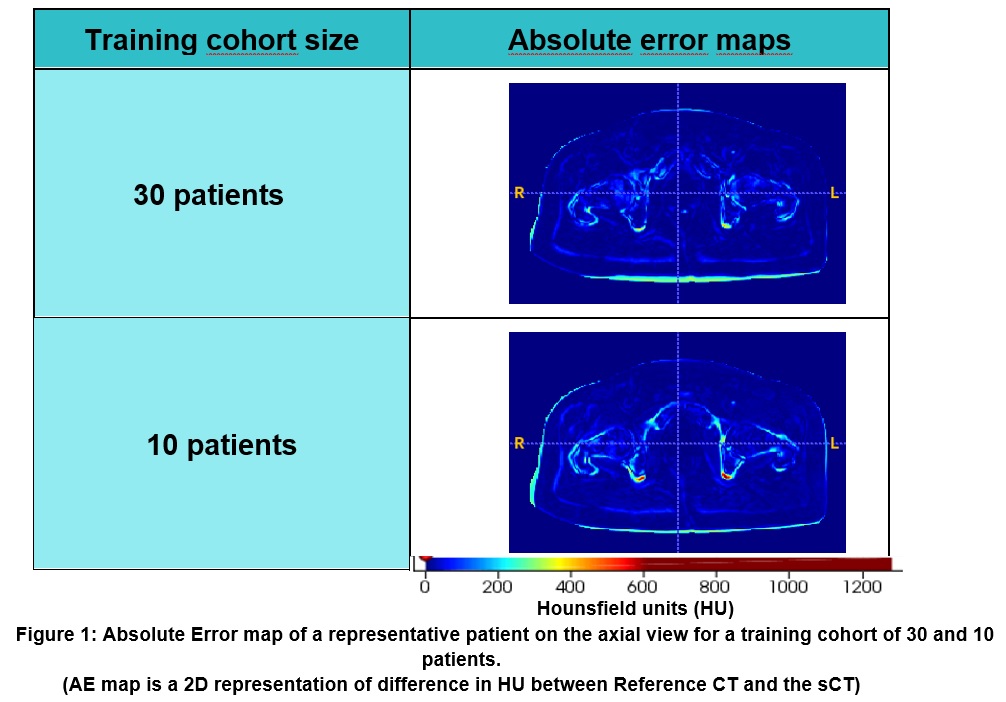Evaluation of prostate synthetic CTs from 0.35T MR images using different deep training cohort sizes
Jean-Claude Nunes,
France
PO-1615
Abstract
Evaluation of prostate synthetic CTs from 0.35T MR images using different deep training cohort sizes
Authors: Jean-Claude Nunes1,3, Lhassa Macque1, Safaa Tahri1, Smaïn Fettem1, Hilda Chourak1, Anaïs Barateau1, Caroline Lafond1, Renaud de Crevoisier1, Oscar Acosta1, Igor Bessieres2, Louis Marage2
1Université de Rennes 1, LTSI (Laboratoire du Traitement du Signal et de l'Image), INSERM UMR 1099, CLCC Eugène Marquis, Rennes, France; 2CGFL - Centre Georges-François Leclerc, Medical Physics, Dijon, France; 3Université de Rennes 1, LTSI (Laboratoire du Traitement du Signal et de l'Image), INSERM UMR 1099, CLCC Eugène Marquis , Rennes, France
Show Affiliations
Hide Affiliations
Purpose or Objective
Several approaches of
synthetic-CT (sCT) generation from MRI have been developed for radiotherapy
dose calculation. Deep learning methods (DLMs) are making steady progress in
improving the quality of sCT from different data inputs. The aim of this study
was to evaluate the impact of the training cohort size on the sCT accuracy from
pelvis MRI-linac data.
Material and Methods
For this study, prostate CT and MR images were acquired in treatment
position for 36 patients. MR acquisitions, using T2/T1-weighted TrueFISP
sequences, were performed with a 0.35T MRI-linac device (MRIdian, Viewray sCT
were obtained by a conditional GAN-based model (Pix2Pix) using the perceptual
loss function and a ResNet 9 blocks generator. The hyperparameters used to
train the model were, a learning rate of 0.001, a beta 1 of 0.7 and a batch
size of 5. The evaluation was performed on a cross validation with five
different sizes of training cohort (30 / 25 / 20 / 15 / 10 patients) in order
to evaluate the impact of the cohort size on the sCT accuracy. Imaging
endpoints were mean absolute error (MAE) in Hounsfield units (HU), and
mean absolute percentage error (MAPE) in % (ideal values: MAE = 0 HU, MAPE =
0%), from comparisons between sCT and reference CT in the body and bones. The
Wilcoxon test was used to compare the results obtained with the training of 30
patients to the other training sizes. Significant differences (*) were considered for p-value<0.05.
Results
Table 1 shows MAE and
MAPE for each training cohort size for body and bones contours. Increasing the
size of the cohort significantly reduces the MAE and MAPE results. No
significant differences were found for a training of 30 patients compared to a
training of 25 patients. Figure 1 shows absolute error maps in HUs of a representative
patient for different number of patients in training.
|
|
Body
|
Bones
|
|
Training cohort size
|
MAE (HU)
|
MAPE (%)
|
MAE (HU)
|
MAPE (%)
|
|
30
|
34.1 ± 8.6
|
1.2 ± 0.3
|
135.2 ± 21.7
|
0.5 ± 0.1
|
|
25
|
33.4 ± 7.7
|
1.2 ± 0.3
|
134.8 ± 19.4
|
0.5 ± 0.1
|
|
20
|
34.1 ± 8.2
|
1.3 ± 0.5
|
142.8 ± 23.7
|
0.5 ± 0.1
|
|
15
|
36.8 ± 9.6
|
1.4 ± 0.4
|
148.3 ± 26.9
|
0.5 ± 0.1
|
|
10
|
38.2 ± 9.2
|
1.5 ± 0.5
|
150.8 ± 29.9
|
0.5 ± 0.1
|
Table 1 : MAE and MAPE results in the prostate treatment area for the 36
patients according to the training cohort size variation.
*: Significant
differences compared to a training cohort size of 30 patients according to a
Wilcoxon Test (p<0.05)

Conclusion
The sCT uncertainties
decrease with a higher number of patient in training. A minimum of 25 patients
in the training cohort size seems to be required to obtain the lowest sCT
uncertainties. A dosimetric evaluation will be performed to assess dose
uncertainties.